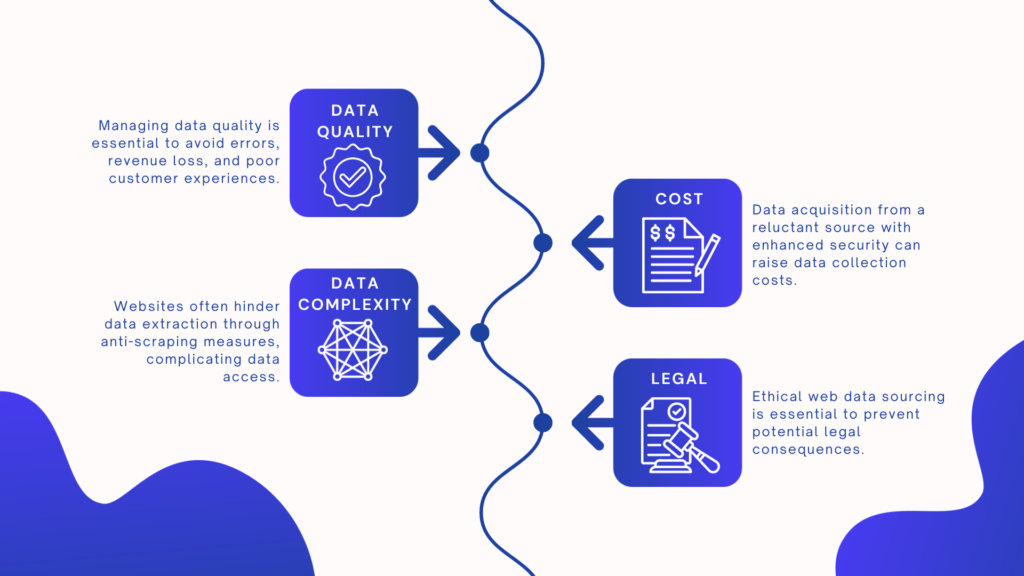Data is an essential part of the growth story of several enterprises around the world. Companies are turning towards multiple sources of information to diversify their dataset and collect insights that might have yet to be known to anyone.
However, to retrieve quality information, the sources must have exceptional and insightful data for accurate analysis.
In this comprehensive guide, we will explore what data sourcing is, the types of data sources, and the challenges businesses face while considering the source as a reliable data provider.
What is Data Sourcing?
Identifying multiple external data sources for decision-making and other relevant business operations within the company is known as data sourcing. The data source is not limited to websites but is diversified to other sources like databases, APIs, and documents.
Data sourcing doesn’t just involve obtaining data from sources; it also includes cleaning, transforming, storing, and integrating it into your services so information is accessible for intelligence purposes within your company.
This process has created a crucial place for itself to make data-driven decisions within the enterprise.
Types Of Data Sources
Information can be gathered from numerous sources, including regularly interacted applications, keyboards, and voice patterns. So, there can be multiple sources, but in this article, we will focus mainly on Primary, Secondary, Internal and External data sources.
Primary Data
Primary data is obtained directly from the source or generated by the enterprise itself. It is known as the direct source of data because no intermediaries are involved in fetching, cleaning, and integrating the data. Companies can generate it in various ways, such as conducting surveys, interviews, research, etc.
Secondary Data
The secondary data is not obtained or generated directly but retrieved from a particular external source. It is cleaned and processed by the same organization that extracted it. It usually comes from search results, social media profiles, articles, books, etc.
Internal Data
Internal data is derived from the company’s historical data records gathered by the company over some time. It mainly consists of user or customer data, transactions, and other relevant records. This data is rarely obtained from an external source until and unless the company has authorized access to it from a service provider.
External Data
External data is not fetched from within the organization but extracted from publicly available information by an automated process or from an organization offering a pre-defined dataset. Examples of external data include Government reports, sector and industrial data, and external readymade database providers.
If you are looking to build a dataset of your own, it might look like a simple task, but a vast infrastructure is required to be maintained, rendering it uneconomical in the long term.
Alternatively, you can look for a readymade data source who has already made the hassle of collecting this data. EnrichmentAPI is one such solution in the market, offering its users the most up-to-date information using its dedicated infrastructure.
Challenges in Data Sourcing

Quality Issues
Quality Issues are one of the major concerns while sourcing data from the web. Poor data quality can generate inaccurate analysis with several side effects, including a fall in revenue, conversation rates, and customer experience.
Data quality issues should be taken seriously and addressed consistently to ensure the reliability and integrity of data. The low-quality and duplicate data should be tested and removed regularly to ensure it doesn’t create any problems for the end users.
Dealing with large amounts of data is not a simple task. It requires a team of experienced professionals who can constantly monitor the data quality, thereby reducing the risk of potential errors that could increase the cost of the supply chain.
Cost Issues
Data acquisition from a source that is reluctant to extract its data for commercial usage may implement several security features that can increase the cost of data collection. Additionally, the cost of extraction and processing of data should be taken into consideration before dealing with large and premium datasets.
Data Complexity Issues
The data extracted from the source is not always available in a structured and accessible format. Websites may use several technologies to prevent you from extracting their data. And, if you can successfully obtain the data, they will ensure that it is returned in a format that makes it challenging to extract information from it.
Legal Issues
It is one of the most commonly asked questions by the data miners. Unethical practice and usage of data without any authorized access or permission from the master’s website can lead to legal consequences and can land your company in trouble. It is crucial to follow an ethical strategy for sourcing data from the web to avoid any legal case in the future.
Steps to Create an Effective Data Sourcing Plan
1. Understand the business objectives
Since we are surrounded by data, to not get overwhelmed by this data sea and not to get misled by any data point that is of no use should be avoided. The objectives and goals of the business should be defined before creating a data-sourcing plan.
Start by identifying the challenges the business is facing currently. For instance, if you are a SaaS platform that offers project management tools. Here are a few questions that you could look to start –
- How can you reduce customer churn?
- What features do users engage with the most?
- Are there any common issues users face leading them to contact support frequently?
- Which marketing channels bring in the most long-term users?
Answering those questions can lead you to the business objective you might have currently. The business goals might change after some time, and since you intend to get better and better over time, it is important to seek what’s currently important for your business.
2. Plan Out Which Data Sources You Need
After identifying what your business needs to thrive, it is important to figure out what data sourcing might best help out.
Let’s say you are a business operating in the B2B space, you do have the companies to whom you want to reach out, but not have the right prospects in those companies.
Here getting a data source that can help you with those prospects would be meaningful. Or since you already have those companies listed with you, data enrichment can be one of the ways to make your data more meaningful.
3. Set Data Rules:
If you source your data from many sources it is important to realize that the data you get isn’t inconsistent or illegal. Setting up rules for your data sourcing process can help you get the right data every time without thinking about any blockage that might occur sometime later.
There might be some steps you can set up as your protocols which would be quality checks, maintaining a clear log, and ensuring you are prevailing data protection laws.
- Start collecting the data: Now you are equipped with the right protocols to get data. It is time to collect it!!
Make sure the data you receive is fresh & relevant. Clean the data, and analyze it for your business.
5. Review & Refine
Remember we mentioned how business goals may differ with time. Always make sure you are getting the right data that is directly referenced to business objectives.
Set a period when you review, if there is a need to collect different data, a different source, or to add multiple sources.
You can revise all these 5 points every quarter.
Impact of Correct Sourcing on Business Growth
Quality sourcing of data is critical to converting your efforts into business success. In this section, we will explore the role played by correct data sourcing in boosting your business growth:

- Informed Decision-Making: Accurate and precise data promotes effective decision-making within the company. When enterprises source reliable information from the internet, they ensure that their decisions based on the extracted information are trustworthy, leading to efficient product development, marketing decisions, and resource allocations.
- Competitive Advantage: Quality data sourcing is the key to moving forward in the competitive market. Correct data sourcing helps businesses gain valuable market insights, know more about their customers, and learn about competitor strategies.
- Targeted Marketing: Highly targeted campaigns can be created through correct data sourcing. Businesses can identify and filter their potential customers based on various criteria such as industry, location, and position to deliver the most relevant messages, thereby increasing conversion rates.
- Resource Optimization: Effective allocation and usage of resources is essential for consistent growth. Companies can stop unnecessary resource wastage causing an increase in operating expenses and a decrease in profitability, by analyzing the data on resource allocation.
Conclusion
Data Sourcing can prove to be a game changer for businesses. It opens several opportunities for businesses and helps in identifying market gaps, trends, and potential areas for product expansion.
In this article, we explored the meaning of Data Sourcing in detail. We also learned how it can help businesses drive consistent growth in their revenue.
If you are looking for a reliable data provider in the market, please do not hesitate to contact us via email.


Comments are closed.